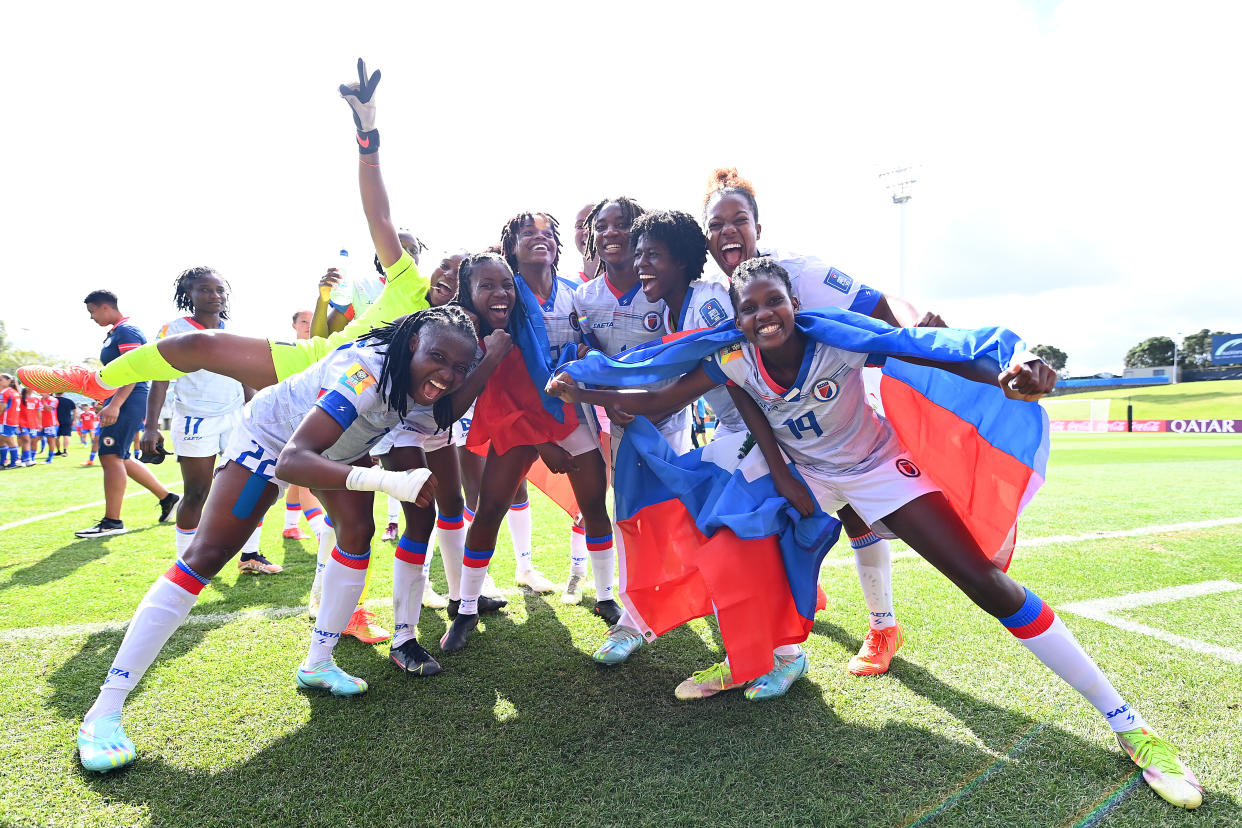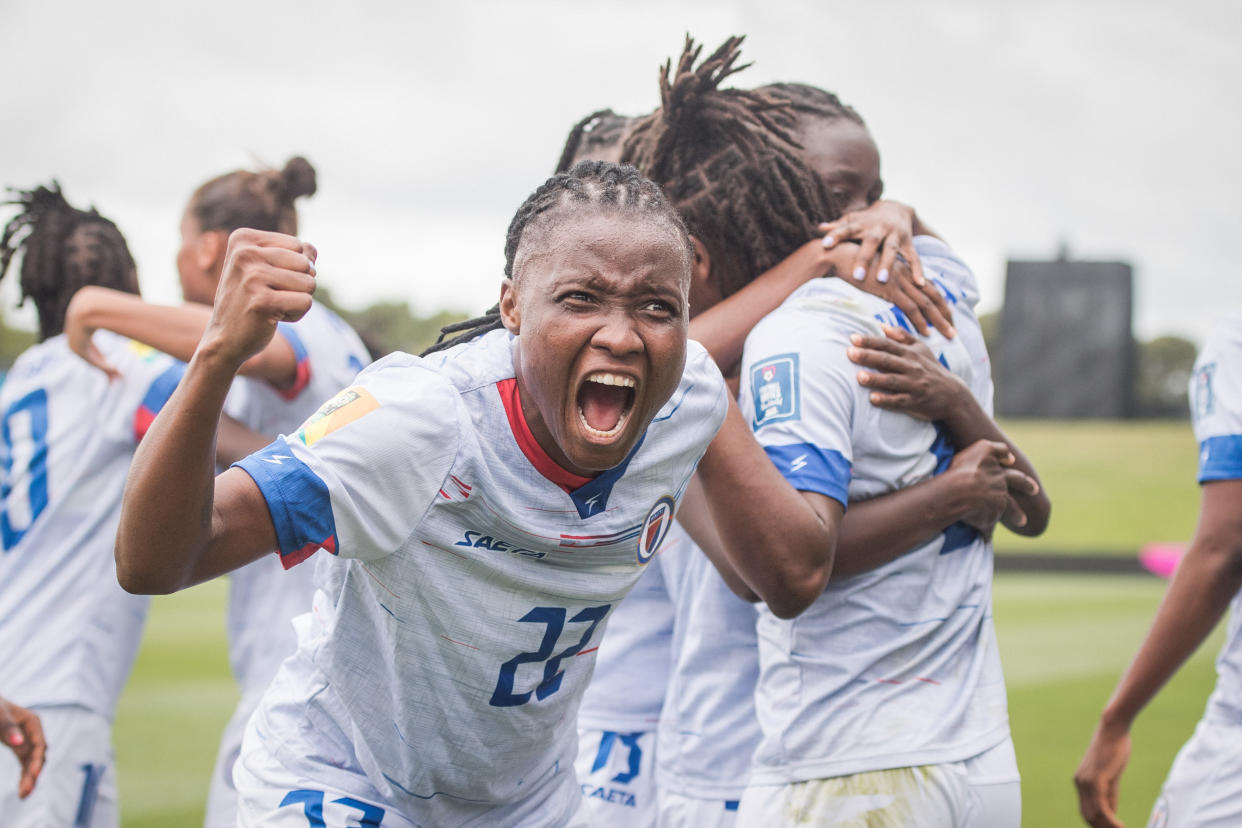How Haiti, amid ‘living hell’ back home, became the ultimate Women’s World Cup underdog
Passion poured out of Haitian players on the eve of the games that meant everything. Two dozen of them had piled into one hotel room on Feb. 17. They sank onto beds, into one another’s laps, onto the floor. They locked eyes in this intimate environment and spoke from their souls about an opportunity they’d earned: Two qualifiers that offered a route to the 2023 Women’s World Cup, which would be Haiti’s first.
But they hardly spoke about soccer that night. For roughly an hour, they preached about their collective purpose. They’d all seen the images and followed the news; they knew their country had descended into violent, ungovernable chaos. They knew it endangered their families. “That's hurt us a lot,” midfielder Ruthny Mathurin said.
They also knew, though, that they could uplift millions of hurting countrymen and amplify an increasingly desperate message.
They can’t provide tangible aid or prevent gangs from ravaging neighborhoods. Over the past two years, ever since the July 2021 assassination of President Jovenel Moïse, those gangs have tightened their grip on a country long plagued by colonial legacies and natural disasters, and dragged it down into an even deeper despair. They have gutted the government — there are currently no elected lawmakers in office — and kidnapped, raped or murdered citizens. They have burned buildings and homes, mostly in the capital. Their terror has shut down schools and shut off access to basic necessities. Well-intentioned humanitarians have fled out of fear for personal safety and cried out to foreign governments for help. When Volker Türk, the United Nations High Commissioner for Human Rights, visited in February, one week before the qualifying playoffs, he called it all “a living hell.” And soccer, of course, won’t remedy any of it.
But to the Haitian players, all of it imbues soccer with meaning. In their captain’s hotel room on Feb. 17, they spoke in their native Creole about this bigger picture, about uniting for this common cause. “The passion,” defender Claire Constant said, “just covered every scared feeling,” replacing nerves with confidence. And 20 hours later, it spilled onto a field.
Haiti beat Senegal in a semifinal, then Chile three days later to secure an improbable World Cup berth. Many of those same players are now in Australia, where they’ll meet mighty England on Saturday. And they’ve vowed that their remarkable story isn’t finished. “If we're here, it's to do something,” Mathurin said. “To keep making history.”
And to keep transmitting that broader message, even 9,000 miles from home, even though significant chunks of their country lack internet access and electricity.
They can’t restore it, but they want Haiti “to know that some people like the country still,” Mathurin said. “Some people fight for it.”
Haiti's history and culture include soccer
Haiti’s present despair can trace its roots all the way back to the Caribbean state’s triumphant beginnings. Its origin story is well-known: In 1791, slaves revolted, overthrew their French masters and won independence. But history largely buried what followed. France, backed by warships, without regard for its own heinous role in the revolution — enslaving Africans and transporting them to the colony in the first place — demanded the equivalent of hundreds of millions of dollars in reparations. Haiti ultimately agreed to pay a majority of the ransom, reportedly 112 million French francs, which, as The New York Times laid out last year, has crippled the Haitian economy ever since.
The United States and others also played roles in inscribing what became cyclical poverty. Haiti entered the 21st century as the poorest country west of Africa. And its location, on a fault line between two of Earth’s massive tectonic plates, kept the vicious cycle churning. A 2010 earthquake killed over 100,000 Haitians and affected millions of the nation’s then-10 million people. After-effects and other disasters have, in many ways, defined the country ever since.
They’ve also skewed Western perceptions. An internet search for “Haiti” nowadays often returns reports of starvation and violence. In a way, all the dire news dehumanized a people who also share a vibrant culture that persists despite what history has thrown at it.
“I promise you there's a thousand amazing things about Haiti that the media does not show,” said Lara Larco, a Haiti women’s national team goalkeeper whose family migrated to Florida when she was 4 after kidnapping attempts on her mom and grandfather.
And soccer, just like griyo or kompa, is part of that culture.
It typically begins in the streets, mostly among boys — many parents tell their daughters: “You can't play soccer,” Mathurin said, and others “look at you in [a] bad way” if you do play — but the girls game began growing last decade. For Mathurin, in Gressier, a modest commune west of the capital, Port-au-Prince, it began as early as she can remember, as soon as she knew “what the ball is, and how to kick it.” She’d play with friends in the street. As a preteen, she moved to a club team. Around age 14, the Haitian Football Federation (FHF) recruited her to its national training center, dubbed the Academie Camp Nous. And it’s there, in Croix-des-Bouquets, another Port-au-Prince suburb, that the 2023 World Cup’s unlikeliest story took shape.

How Haiti's World Cup team came together as teens
The recruitment efforts would frequently begin even before age 14. The FHF would scout young girls and bring them to the training center, where it had built a residential academy. Dozens of teens would sleep in cramped quarters and attend school in between training sessions, “but school was not our first track,” Mathurin said. “We want to go pro and make our family proud, make money.”
Many of them, according to players, saw soccer as their way out of poverty, their escape from the gunshots that ring daily and from lives that offered scant opportunity.
“Playing soccer was gonna help them get out of their country and get out of the misery,” said Larco, who spent most of her childhood in the U.S. but has spoken with teammates about the dynamic. Many dreamed of being “able to go abroad and live in better conditions and be able to make money and provide for their families back home,” Larco said. “So it was more than just a sport.”
And it’s this ambition that longtime FHF president Yves Jean-Bart, known as “Dadou,” allegedly exploited. In April 2020, numerous sources alleged to The Guardian that Jean-Bart had sexually abused young female players. Jean-Bart denied the accusations, and earlier this year had his lifetime ban from soccer overturned by the Court of Arbitration for Sport. But FIFA, soccer’s global governing body, argued that the verdict contained “very serious procedural and substantive flaws." FIFA’s ethics committee judges had previously said they believed the allegations of rape, and that “many of the girls from very poor backgrounds became known as [Jean-Bart’s] ‘restaveks,’ a Haitian term for a child slave.”
The young girls also lived in conditions that have been described as unsanitary, “totally unacceptable” and “hell.” Larco got brief glimpses when she went to train at the center as a teen. “They had little houses, and I was able to go in them,” she said. “And it was definitely eye-opening for me, coming from Florida, to see the conditions in which they lived. They would eat spaghetti and ketchup, lunch and dinner.”
Many, though, would endure it all as a means to a brighter end. They’d awake everyday around 6 a.m. — “sometimes 5,” Mathurin said — and train until 8 or 8:30. Classes would start around 9, after breakfast and a quick shower. They’d adjourn for the day around 3, and later, soccer would resume.
The girls would train twice a day, week after week, battling for places on youth national teams. They also forged a sisterhood that bonds them to this day. Several rose together from the Under-17s to the Under-20s to the senior team. And they’ve been led all along by one generational talent, Melchie “Corventina” Dumornay.
Dumornay had been discovered around age 10 in another commune, Mirebalais, northeast of the capital. To Mathurin, her brilliance was evident immediately; players also hail her personality and leadership as linchpins of their tight-knit soccer family. Dumornay drove that family to the 2018 U-20 World Cup. She ascended to the full national team and became its shining star at age 18.
And she wasn’t alone. A youthful squad entered last summer’s CONCACAF qualifying tournament buoyed by optimism. It stunned Mexico, 3-0, in its second game, and “that was when we all believed,” Larco said. “Like, wow, we can do anything with this passion.”
They partied in the locker room afterward, bumping Afrobeats and dancing. They then lost to Jamaica with a World Cup spot on the line. But they qualified for February’s intercontinental playoffs.
By the time they arrived in New Zealand for those playoffs, violence had continued swelling back home. The national training center has shuttered; a powerful gang now controls the surrounding area. Players have moved abroad and convened only sparingly for training camps. Some haven’t returned to their native land in months or years. All they knew of its current state was through word-of-mouth and videos.
But they still care deeply for it. When they beat Chile in the playoff final, some dropped to their knees and burst into tears. Joy propelled them all over the field, then back to a raucous locker room. It followed them to breakfast the following morning, when some were able to connect with family members by phone. And that’s around the time they began to see a different type of video.
“The country's going crazy,” Larco’s family and family friends told her. “Everyone was on the streets — happy, excited.”

Haitian players aim to inspire hope
Happiness, excitement and most of all hope are what the players want to inspire Down Under.
It’s precisely what has eluded so many Haitians recently. It can feel unattainable when everyday life is disturbed by fear. Even good deeds can feel futile. Light at the end of the proverbial tunnel can disappear.
But “light,” defender Milan Pierre-Jerome said, is what “we can continue to bring.”
They can’t reverse the course of the country. They can’t compel a robust multinational police force to step in — an intervention that has become necessary, U.N. and U.S. leaderssaid recently.
But they can arouse belief that it will come, or, more generally, that the future will be brighter than the present.
“I think about the little girls who grow up and can have something to aspire to,” said Constant, who is missing the World Cup due to injury but clinging to positivity all the same. “They can work towards something, and know that there's something bigger out there for them.
“That's what I think it means to this country: There's something more out there. Just look at the girls, look at the team, they've done it, they're doing it, they're going to the World Cup. And I hope it inspires girls and boys, little kids there, to have hope.”
